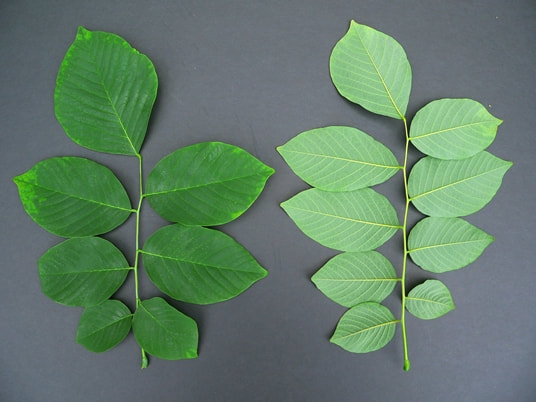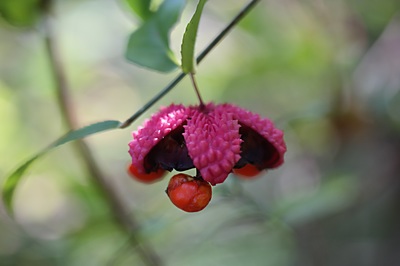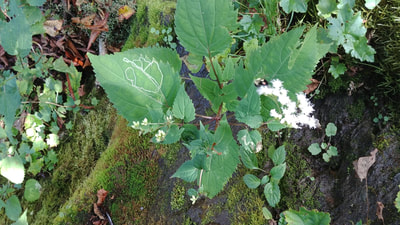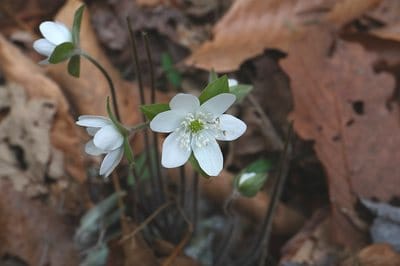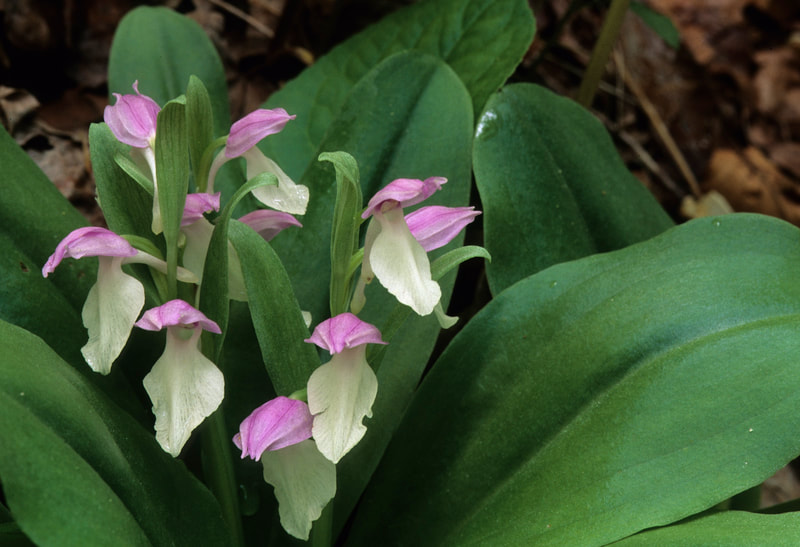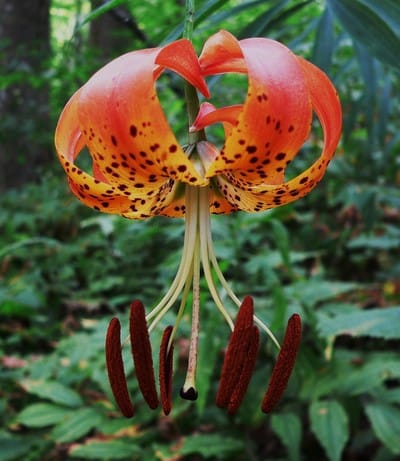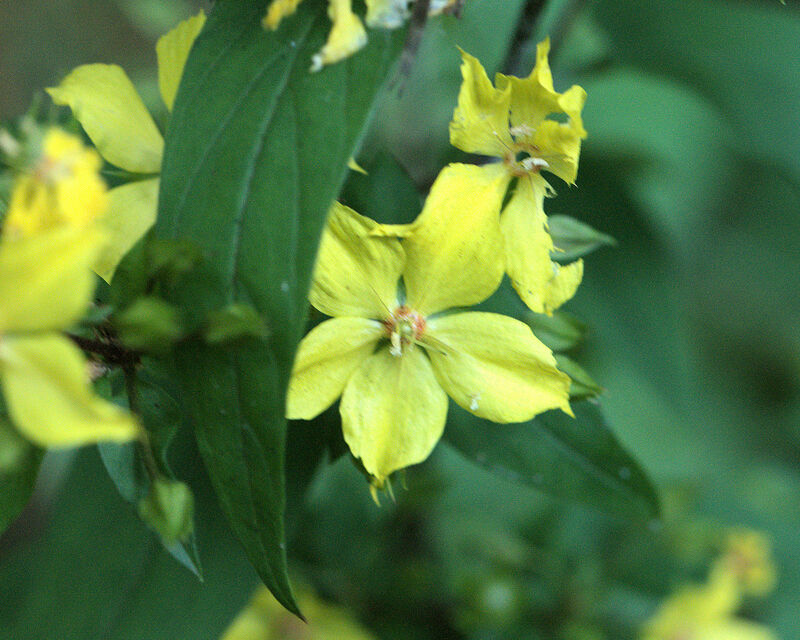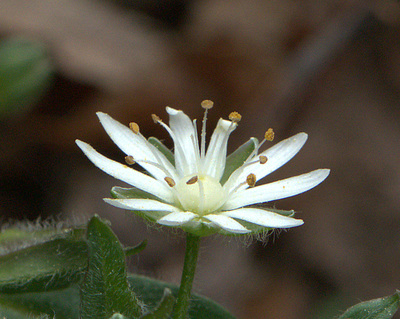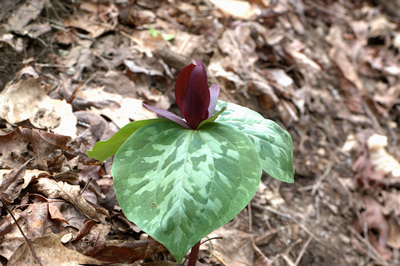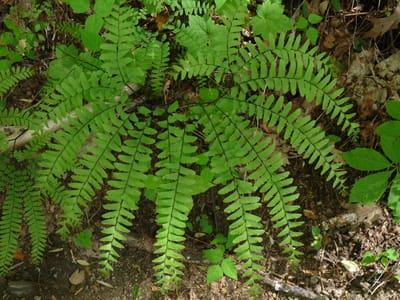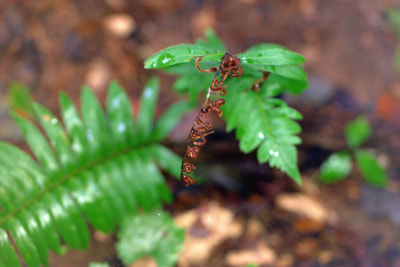Fertile Cove Forests
|
Blue Ridge Fertile Cove Forests are lush, moist forests that grow below roughly 3,500- 4,000 feet, most often in concave-shaped sites that are north-facing coves, but sometimes on moist, protected slopes facing other aspects. Indicator species include yellow buckeye, white basswood, yellowwood and southern sugar maple. They have deep, rich, soils with high nutrient levels. Fertile mountain coves can be very diverse, and are spectacular in the spring, with lush, diverse carpets of wildflowers that flower before the trees leaf out. Animal diversity, including salamanders, snails, millipedes, and birds, is also high.
What's special: the beauty of the spring wildflowers, the presence of many rare and endemic species, the lushness of the habitat, the huge size reached by old-growth trees, and the diversity of the flora and fauna of fertile Blue Ridge coves make them among the most beautiful forests in the world. Conservation: these habitats depend upon gap-phase dynamics, where small disturbances, such as the death of a tree or even a large limb, release young trees into the canopy in small numbers and create a multi-aged forest. They should be protected from fire, logging, and other human activities that create medium to large disturbances. Blue Ridge cove forests should be conserved and treasured for their age and diversity. Related communities: As sites become drier, they grade into Oak Forests. Upslope they grade into Northern Hardwoods. Seepage Wetlands and Spray Cliffs communities are often embedded. Fertile coves can also intergrade with acidic coves, where plants from both types of natural community will occur in relative abundance. |
Landscapes
Birds |
|
Plants Click on a plant name to see images. Plants are listed in order by scientific name. Soil/bedrock nutrient traits, such as "rich", "basic", "calcareous" and "mafic" are from The Flora of the Southern and Mid-Atlantic States, here. Trees Southern sugar maple Acer floridanum (especially but not limited to calcareous and mafic soils) Northern sugar maple Acer saccharum Yellow buckeye Aesculus flava Musclewood/American hornbeam Carpinus caroliniana Bitternut hickory Carya cordiformis (especially in rich soils) American (white) beech Fagus grandifolia White ash Fraxinus americana (rich soils, and in calcareous or mafic soils on dry sites) Yellowwood (Cladrastis kentukea) Common silverbell Halesia tetraptera Tulip-tree Liriodendron tulipifera Cucumber magnolia Magnolia acuminata (especially but by no means strictly over mafic or calcareous rock) Umbrella magnolia Magnolia tripetala Red mulberry Morus rubra Ironwood/ American hornbeam Ostrya virginiana (especially over basic bedrock) Black cherry Prunus serotina Northern red oak Quercus rubra White basswood Tilia americana var. heterophylla (rich soils) Shrubs and Vines Mountain sweet pepperbush Clethra acuminata Northern leatherflower Clematis viorna (esp. over mafic) Strawberry bush Euonymus americana Smooth hydrangea Hydrangea arborescens Northern spicebush Lindera benzoin (circumneutral soils) Ground Cover Wildflowers Dolls'-eyes Actaea pachypoda (rich forests) Black cohosh Actaea racemosa (rich to very fertile forests) White snakeroot Ageratina altissima Fly-poison Amianthium muscitoxicum Sharp lobed hepatica Anemone acutiloba Round lobed hepatica Anemone americana Jack-in-the-pulpit Arisaema triphyllum Wild ginger Asarum canadense (rich, circumneutral soils) Cutleaf toothwort Cardamine concatenata (rich forests) Broadleaf toothwort Cardamine diphylla (rich forests) Blue cohosh Caulophyllum thalictroides (rich forests) Devil's-bit Chamaelirium luteum Northern horsebalm Collinsonia canadensis (rich forests, especially over mafic or calcareous bedrock) Bearcorn Conopholis americana (near oaks) Yellow lady's-slipper Cypripedium parviflorum (rich forests) Harbinger-of-spring Erigenia bulbosa Dimpled trout lily Erythronium umbilicatum Showy orchis Galearis spectabilis (rich forests, typically over calcareous or mafic rock) Wild geranium Geranium maculatum Summer bluet Houstonia purpurea Crested iris - Iris cristata (rich forests) Wood-nettle Laportea canadensis Turks-cap lily Lilium superbum Fringed loosestrife Lysimachia ciliata Sweet cicily Osmorhiza longistylis Ginseng Panax quinquefolius (nutrient rich forests though tending to avoid richest coves) Blue phlox Phlox divaricata (circumneutral soils) May-apple Podophyllum peltatum (rich forests) Yellow mandarin Prosartes lanuginosa Bloodroot Sanguinaria canadensis (nutrient-rich forests) Axillary goldenrod Solidago caesia Star chickweed Stellaria pubera Rue anemone Thalictrum thalictroides Foamflower Tiarella cordifolia Catesby's trillium Trillium catesbaei Sweet Betsy/Toadshade trillium Trillium cuneatum (rich forests, usually over mafic or calcareous rocks) Large-flowered trillium Trillium grandiflorum (rich forests) Nodding trillium - Trillium rugelii (rich forests, usually over mafic or calcareous rocks) Sweet white trillium Trillium simile (over mafic or calcareous rocks) Vasey's trillium Trillium vaseyi (rich forests) False hellebore/mountain bunch-flower Veratrum parviflorum Ferns Northern maidenhair fern Adiantum pedatum (especially over mafic or calcareous rocks) Southern lady fern Athyrium asplenioides Rattlesnake fern Botrypus virginianus (especially on nutrient-rich slopes) Silvery glade fern Homalosorus pycnocarpon (very nutrient-rich forests over mafic or calcareous rock) New York fern Parathelypteris novaboracensis Broad beech fern Phegopteris hexagonoptera Southern grape fern Sceptridium biternatum |
Representative trees in order by scientific nameRepresentative ShrubsGround cover in order by scientific nameRepresentative ferns in order by scientific name
|






